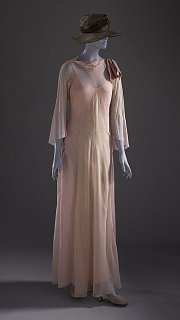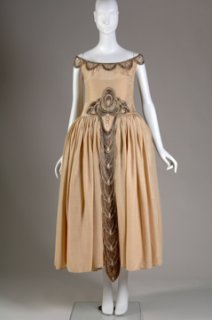Lanvin: a hidden allure
25/11/2007
Jeanne Lanvin's exquisitely flattering couture rivalled Coco Chanel and anticipated Dior, yet she herself was middle-aged and far from glamorous. Linda Grant reveals the history behind the world's oldest fashion house
'This distinguished elderly woman, wearing a black dress, a red- and silver-paillette jacket, her wealth of hair coiled on her head in exactly the same chignon that she wore 20 years ago, and some lovely jewels around her neck, came in and made a tour of the room, like royalty, smiling and greeting everybody.'
The grande dame, described in Vogue in 1932, was one of the greatest and least-known designers of the 20th century. When Alber Elbaz took over as the head of Lanvin in 2002, marking a sensational comeback for the half-forgotten house, few people remembered that during her heyday in the 1920s Jeanne Lanvin had rivalled Chanel. The name conjured up for me an expensive, decorative sophistication. I saw her as a designer who clothed women of a certain age. Hers was a label you might aspire to but never quite reach. In fact, I have, unknown to me, been wearing a dress based on Lanvin's landmark shape, the robe de style. My version is by Ghost, but the silhouette is more or less identical. It consists of a dress with a full skirt gathered from a slightly dropped waist, with flat panels at front and back, the hem falling a little above the ankles. Softly feminine, universally flattering, it acknowledges that a woman has hips and a stomach she doesn't want to exaggerate with bunched-up fabric. The robe de style was the look of the 1920s for women who could not wear the tubular lines of Chanel. Move the waist up, and it prefigures, by a quarter of a century, Dior's New Look, launched the year after Jeanne Lanvin died. And, of course, in fashion there is nothing new under the sun. The robe de style was itself based on what had gone before, Infanta frocks, Camargo frocks, picture frocks, portrait frocks - all those bouffant styles are what a woman needs who wishes to conceal the flaws in her figure.
'Fashion is not a sketch with a front and a back view. It's about what exists between the drawing and the outfit: woman,' Alber Elbaz writes in his foreword to a fascinating new book on Jeanne Lanvin. She was born in 1867, the eldest of 11 children. At the age of 16 she was apprenticed to a milliner in Paris, setting up her own shop in 1889 on the rue du Faubourg St-Honoré. At the age of 28 she married her first husband, Count Emilio di Pietro, an Italian nobleman, and two years later gave birth to her only child, Marguerite. The couple divorced in 1903, and four years later she would remarry, but it was her daughter who would become her fashion muse.
Lanvin lavished attention on Marguerite, dressing her as a kind of mini-me. In 1908 she moved away from millinery to design her first collection of childrenswear, clothes for the little-girl-about-town, using sophisticated textiles and colour - a rose-coloured silk dress with a collar of gold lace. You can take it for granted that if Lanvin were around today, every red-carpet entrance would be accompanied by a child dressed from head to foot in a miniature robe de style.
Lanvin was in her fifties at the beginning of the 1920s, a generation older than her chief rival, Chanel, when she became famous as a dresser of grown-ups. She simply continued the bouffant style (today we would call it 'volume'), which was the hallmark of Paul Poiret. Her clients were wealthy women, from debutantes to the mother of the bride. She did make the tubular silhouette: there is an original gouache design for a dress called the Fausta, and the dress itself in navy silk-chiffon with beaded and embroidered sleeves, evoking Crusader imagery, is seen in a contemporary photograph, worn by Princess Faucigny-Lucinge, an apple-shaped, thick-ankled lady, with a lot of fabric creases round the middle. It was an unforgiving shape for the unyoung and unslim.
An acute observation in the book reminds us that women in the 1920s were the first to be seen in significant numbers out of doors - shopping in the new department stores, going out to work, sitting in cafés - rather than in the closed quarters of the salon. They were the first fashionable women to be observed from afar; it was their shape that counted. Lanvin was old-fashioned in that respect: the beauty of her dresses was to be observed close-up, in the detail.
They were richly decorated, using couture embroidery in which Catholic symbolism figured, as well as beading, expensive fabrics and colour inspired by the Orient. She set up her own dye factory in 1922, creating exclusive colours that could not be duplicated, such as rose polignac invented for her daughter, and Velásquez green. Looking at the pictures of her clothes, I am reminded of Alberta Ferretti, another woman designer who knows how to dress a woman and make her feel like a woman. These are not exactly clothes for the working girl.
The difference between Lanvin and Chanel could not be greater. Coco Chanel was an abandoned child, then a mistress, then a single, hard-nosed businesswoman who had affairs instead of children. Jeanne Lanvin came from bourgeois respectability and entered the haut monde through her (brief) first marriage, then her second, to a journalist and diplomat. She was devoted to her family and stayed within a small private circle of friends, mostly artists. She read deeply and widely in the history of art, symbolism and representation. To see her interior world, one can go to the Musée des Arts Décoratifs in Paris and view three of the newly restored rooms she designed in collaboration with Armand Rateau, celebrating the 1925 Art Deco exposition. She lived for her work, often spending more time in her office than at home. When she died, Lucien Lelong, head of the Chambre Syndicate recalled that 'she lived in the suburbs and took the last train before starting again the next day. No free Saturday, no Sundays.'
And that was the problem. Lanvin had no public image, no personal public relations in an industry where her rivals Poiret, Chanel and Schiaparelli all understood that they needed to embody their house in their own appearance; all three were tireless self-promoters. It didn't help that she was already well into middle age when she became famous. Karl Lagerfeld wrote of her, dismissively, 'Her image was not as strong as that of Chanel because she was a nice old lady and not a fashion plate.' At the height of her fame she wore not a robe de style, but discreet black-and-white outfits with minimal detail, and simple pearls - paradoxically, a minimal, Chanel-like palette. But she was never designing for herself, only for her beloved daughter, who would take over after her mother's death.
The Lanvin label passed from hand to hand, neglected and almost forgotten, submerged in the deals and mergers of the modern luxury-goods market, a faint echo of a past that could only be conjured up by sniffing a long-ago trace of scent. Yet by the time Elbaz took over in 2002 it was the oldest fashion house in continuous operation, having been founded in 1909, and despite its dimmed reputation, it somehow survived and overnight became the most covetable designer label on the planet.
Elbaz was an unlikely successor in all but shape: born in Morocco, he grew up in Israel and has Jeanne Lanvin's portly body type. There are references to the robe de style in his designs, but what he has inherited from the founder of the house is an understanding of colour and femininity. 'I believe in covered allure,' he writes. 'Someone said to me they love Lanvin because they're the kind of clothes that make a man fall in love. What I want is clothes to make the woman who wears them fall in love, clothes that follow, rather than sex up the natural curves of the female form.'
Jeanne Lanvin: wore a minimal, Chanel-like palette
Robe de style with silver lame fichu collar
Lanvin (Rizzoli, £45) by Dean L Merceron and Alber Elbaz is out now



















